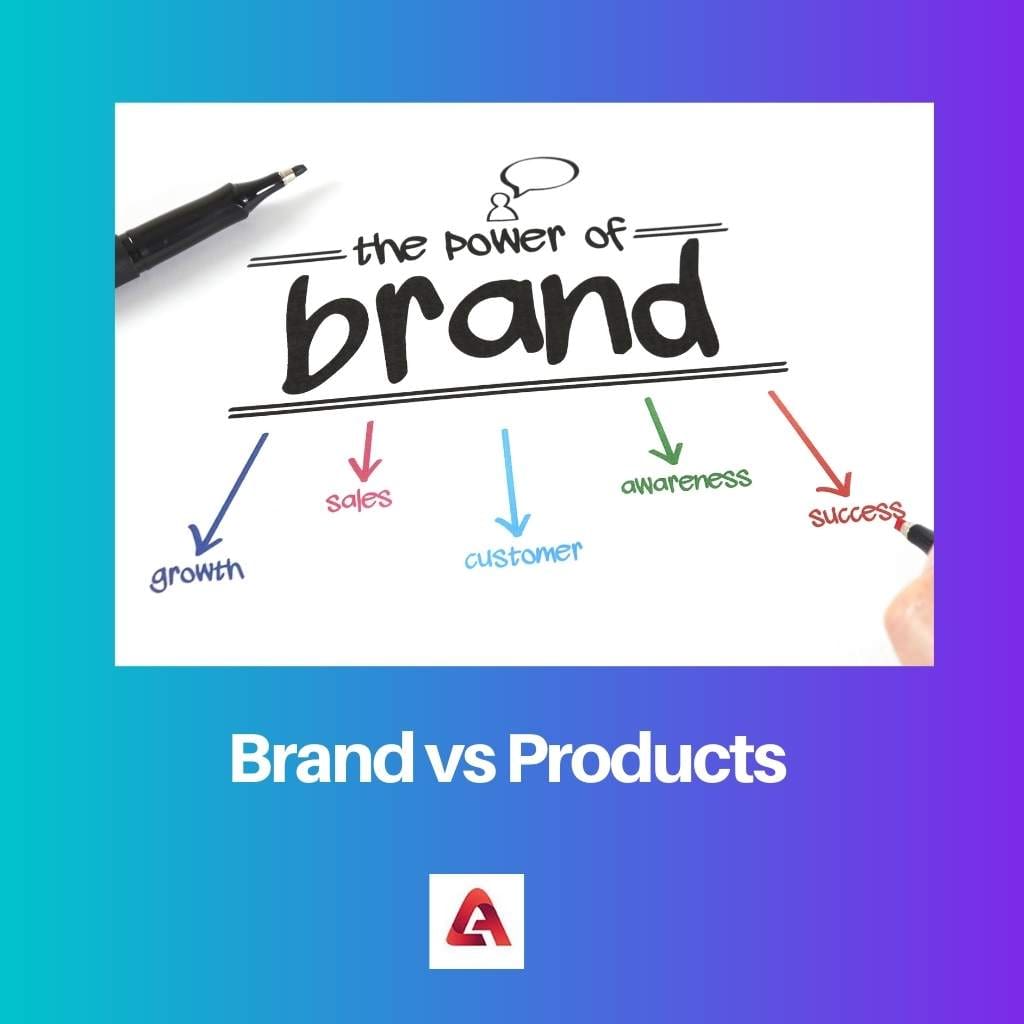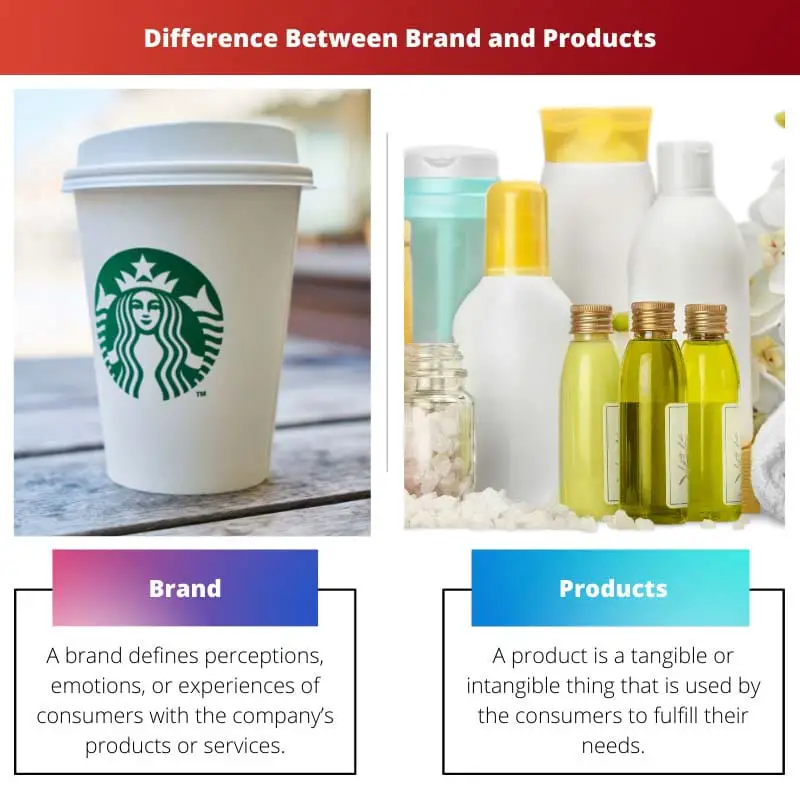Products and brands are the sources of profit or revenue for the organization. Business organizations invest a lot in product and brand management to enjoy several competitive advantages over their competitors.
In the business market, consumers use the words “product” and the “brand” mostly before making purchasing substitute products.
Key Takeaways
- A brand is a unique name, design, symbol, or other feature that identifies and distinguishes a company’s products or services from those of others; a product is a tangible item or service offered for sale.
- A brand is used to create an image or identity for a company and its products; a product is what the company sells to its customers.
- A brand can add value to a product and influence customer loyalty and perception; a product’s value is determined by its quality, features, and price.
Brand vs Products
A brand is a name, term, design, symbol, or other feature that distinguishes one seller’s products or services from those of others. A product is a tangible item or service that is offered for sale to customers and can be physical, like a car or a smartphone, or intangible, like a software program.

A brand is a mechanism or a tool used by every organization to create awareness of the product or service, increase loyalty, and differentiate the product from its substitutes.
A product has different characteristics and functionalities that are used to make a brand. A brand is a promise made by the organization indirectly to the consumers that they value consumer interests and needs.
A product is a finished good or service developed to ease a human’s work. In the business market, multiple organizations can produce substitute products and price them differently to gain profit over others.
In the business market, multiple organizations can produce substitute products and price them differently to gain profit over others. The product’s final price is set by estimating the quality, costs of manufacturing, features, and benefits of the product.
Comparison Table
| Parameters of Comparison | Brand | Products |
|---|---|---|
| Definition | A brand defines perceptions, emotions, or experiences of consumers with the company’s products or services. | A product is a tangible or intangible thing that is used by the consumers to fulfill their needs. |
| Substitutes | A brand does not have substitutes. | A product is substituted by other companies by adding more features and increasing quality. |
| Created by | The brand is created by the consumers after experiencing the product or service. | A product is manufactured by the manufacturer. |
| Replacement | Brand lasts forever once is it’s built in the minds of consumers. | A product is replaced by another new or highly featured product as time passes by. |
| Aspect | It is a non-physical thing that can only be experienced. | It can be both physical and non-physical thing. |
What is Brand?
A brand is a mechanism used to differentiate the product or service of one company from its substitutes. It is a competitive asset of every organization.
It not only indicates the company but also expresses the emotions and perceptions of consumers who have used the products of a particular brand. It is the image in the minds of consumers.
Brand helps to increase the sales of products and services of the company by creating awareness of the same in the market.
A brand is not just a logo of the company, but it defines the objectives and vision of the company and how it successfully achieved it. A brand adds value to the products and increases sales.
A brand is created through a strategic process in which the company’s external constituents and internal ambitions are combined. The branded product will be expensive and have higher demand than the non-branded items.
It denotes the loyalty and trust of customers in the products.
The organization has to maintain its brand by ensuring the quality of its service. The brand is also marketed using brand management strategies to create awareness in the market of the particular brand and the products.
It expresses the culture and environment of the organization. A successful brand will not only increase sales but also provides new growth opportunity to the organizations in the market.

What are Products?
A product has different meanings in different fields as it is a finished good in the manufacturing industry; it defines the objectives of the project in project management, a product that satisfies the needs of consumers in the marketing industry, and so on.
Organization research and identify the needs of targeted consumers to develop new products or services. A product is successful in the market only when it satisfies the needs of customers. A product generates revenue for the organization by fulfilling the needs of consumers.
The organization uses a product development cycle to develop, launch, maintain, market and sell the product in the market. The product goes into different stages: introduction, maturity, growth, and decline.
The organization uses marketing techniques and technology to market and create awareness of the product availability either through online marketing or television ads.
New startups and substitute companies enter the market once the product starts giving profit to the company. A company can add more features and upgrade the product to achieve competitive advantages over the substitutes.
The product becomes successful only when the product quality is good and the pricing and marketing strategies are effective. The organization creates multiple products and services are grouped under one umbrella referred to as a brand.

Main Differences Between Brand and Products
- A brand is a market image of the products or services of the organization in the market, whereas the product is a useful thing that fulfils the needs of targeted consumers.
- Once built, a brand lasts forever in people’s minds, whereas a product is replaced with a new product with new and advanced features.
- A brand is built by combining the consumer experience, emotions, and the organization’s visions. On the other hand, a product is developed by the manufacturing team to fulfil the needs of consumers.
- A brand cannot be substituted as it is unique to other brands, whereas a product has several substitutes in the market with the same or advanced features.
- A brand adds value to the products or services, and a product fulfils the general needs of consumers.


The article provides a comprehensive overview of the different meanings and applications of products in various industries, offering insights into the multifaceted nature of product definitions across different domains.
The discussion on how brands denote the loyalty and trust of customers, and the strategic process involved in their creation, offers a detailed understanding of brand significance in the business market.
I agree with your assessment, the article effectively captures the essence of brand influence on customer trust and loyalty.
The article effectively compares and contrasts the definitions and roles of brands and products in the business market.
The article elaborates well on the significance of a brand in creating an identity and differentiating products in the market. It also highlights the role of brands in influencing customer loyalty and perception.
Absolutely, the distinction between brands and products in terms of their influence on customer perceptions is well-explained in the article.
The article effectively showcases the importance of research in identifying consumer needs to develop successful products, highlighting the core principles of product development in the market.
Absolutely, the focus on consumer needs and product development in the article is particularly insightful and resonates with the fundamental principles of market success.
The article effectively emphasizes the significance of targeted consumer research in driving successful product development, offering a comprehensive understanding of the market dynamics.
The explanation of the creation and maintenance of brands, and the focus on quality and consumer perception, is a valuable insight provided by the article.
I completely agree, the article offers an in-depth understanding of how brands are developed and maintained to add value to products.
The article provides an insightful overview of the significance of a brand in creating awareness, expectation, and value for products in the market.
The details about how brands express the culture and environment of an organization are particularly interesting and add depth to the understanding of brand impact.
I completely agree with your observation, the article effectively highlights the impact of brand creation on product value and perception.
The article does a great job of explaining the key differences between brands and products and how businesses invest in product and brand management for competitive advantages.
I agree, the article provides a clear and concise overview of the importance of brands and products in the business market.
The article provides a comprehensive explanation of how brands contribute to increased sales and customer loyalty, offering valuable insights into brand management strategies and their impact on the market.
Absolutely, the article succeeds in illustrating the multifaceted role of brands in adding value and fostering trust in consumer perception.
The comparison table effectively summarizes the differentiation between brands and products, making it easier to comprehend their distinct characteristics in the market.
Yes, the comparison table is quite informative and enhances the understanding of brand and product distinctions.